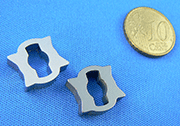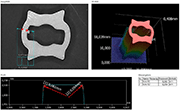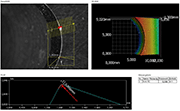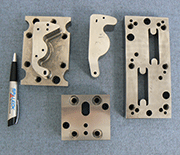E-Archive
Good Vibrations
in Vol. 18 - July Issue - Year 2017
Wash Me, But Do Not Make Me Wet – Surface Finishing With Extreme Requirements

Picture 1

Picture 2

Picture 3

Picture 4
Mass Finishing is one of the most important finishing processes in the metal and other industries. It is in most cases a robust and simple application with repeatable results. Mass Finishing is carried out in vibratory bowls, centrifugal finishers or drums of different forms and sizes, often supplemented with various additional peripheral units like conveyors for the part transport, washing or sorting units.
The different treatment targets of mass finishing could be deburring, polishing, edge-breaking, smoothing, shining etc. The workpieces to be machined are, together with abrasive bodies, placed into a loose filling into a working container. The relative movement between the chips and the parts then produces the pressure required for the abrasive effect. Water and chemical additives called compounds are further ingredients to that process.
Sometimes the treatment success is visible clearly at the workpiece itself. However, increasingly frequent simple targets of polishing and deburring a burr visible to the human eye or being palpable for the human hand are replaced by more sophisticated targets, which have special quantifiable conditions to be matched.
These conditions could for example be a certain number of roughness, measured in Ra and Rz values, or a certain value of edge rounding, measured in mm or µm of a radius. Equipped with suitable modern measuring technology, the building of the surface finishing process with repeatable results to achieve such detailed specifications is no problem.
Surface Finishing becomes a balancing act, when you have to combine two contradictory finishing targets. For example, if you have to deburr an edge, which should not have been rounded up, so that it stays quite sharp. That is the case when deburring a punching tool. On the one hand, you have to remove a burr at the edge, but on the other hand, the edge should stay sharp in order to fulfil its punching tool purpose. Another extreme finishing target is to deburr workpieces, which are extremely hard, for example, circuit boards made of hard sintered metal.
But before we take a closer look on these extremities, let’s shortly consider how one central aspect of the mass finishing process, the material removal, is working. The following general insights into this process are based on experiments done for a scientific thesis made by Herbert Hoffrichter, head of construction at Spaleck Oberflächentechnik.
The material removal is amongst other things a measuring scale for the abrasive effect, which is exercised by different chips types (grinding stones). In experiments you can see, that there are certain general trends, even when conducted in a roundtub vibrator. Therefore, you can say that the material removal rate per time unit will fall from relatively high starting values within a short time to lower values, ending with a nearly constant value. After just 1 to 2 hours of machining time, a linear increase in the material removal of the piece weight is achieved with strongly grinding ceramic chips, which corresponds to a constant material removal per hour. The bulk of the material removal is caused by the chips.
The hard abrasive materials embedded in the base substance remove the surface roughness of the workpieces and chip out additional material from the surface.
The contact pressure between chips and workpiece required for the grinding process consists of the hydrostatic pressure in the bed and the dynamic pressure from the flow velocity between the parts. The hardness of the workpieces counteracts the penetration of the abrasive grain into the material surface.
Soft materials can withstand the hard abrasive grains of quartz, corundum, silicon carbide or boron carbide less well than hard materials. They leave deep abrasive ridges in soft materials. At the edges of the grinding ridges, the material will also pile up with low hardness and high fracture toughness. A further phenomenon is the elimination of material particles from the material surface by the grinding chips.
The harder the material and the lower the fracture toughness, the more the removal of material displaced from the micro-plowing to micro-machining and at least to micro-fracturing. In this case, only roughness peaks located on the surface are removed and protruding edges and ridges are broken because the hardness of the workpieces scarcely permits penetration of the abrasive grain into the surface. In these areas, a greater consumption of the abrasive chips also occurs, which leads to an additional reduction in the grinding effect.
As we can see, the abrasive effect is a complex function of machine hardware and settings, grinding stones and the workpiece material itself. Nevertheless, sometimes there is a further dimension, the dimension of the chemically accelerated finishing. In this case, aggressive acids are used to strengthen the abrasive effect.
If your finishing target is to deburr workpieces, which are extremely hard, for example, circuit boards made of hard sintered metal (pictures 1 and 2), one possibility is to use IDU compound to get control over the hard material. Together with the extremely hard stones PS2 and an extraordinary long centrifugal treatment time of 3 hours, the burr could be eliminated. Due to the IDU process, you need another 2 hours of polishing the surface in order to remove the black colour -an IDU effect - from the surface.
The opposite of that is the deburring case of a punching tool. So here, on the one hand, you have to remove a burr at the edge, but on the other hand, the edge should stay sharp in order to fulfil its punching tool purpose (pictures 3 and 4). Even that is possible. Very short vibratory cycling times of approximately 15 minutes in a flat trough vibrator combined with very weak grinding chips MF 3x5 ZS, which have a high density, led to success. At the end of long trials, the weak burr could be eliminated, and the edge still stay sharp enough to serve the part purpose of a punching tool.
So finally, we see that in spite of the fact that vibration is at first sight a very raw and intensive force, there is in most cases a way to control and canalize its effect by the process parameters at hand to suppress the "bad vibrations" and to use the good sides of vibration.
Good Vibrations
by Mathieu Geuting
Spaleck Oberflächentechnik GmbH & Co. KG, Germany
Tel. +49.2871.9500 14
Fax +49.2871.9500 95
E-mail: m.geuting@spaleck.biz



























